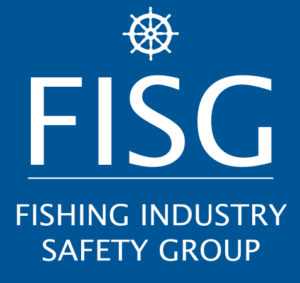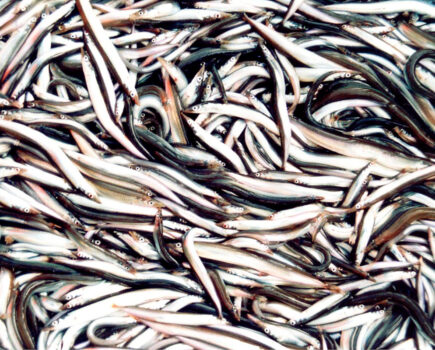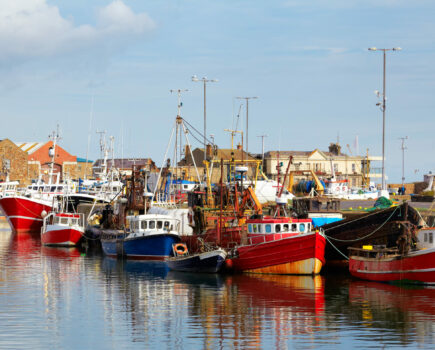After a busy few weeks, all of the nominees for this year’s Fishing News Awards have been assessed, the shortlists for each category have been drawn up, and voting is now open.
So now it’s over to you, and it really couldn’t be simpler. Just click here and place your vote for your favourite candidate in each category.
Eleven of the categories will be decided by you, our readers, while the remaining four – Young Fisherman of the Year, the Sustainability Award, Port of the Year and the Lifetime Achievement Award – will be decided by a panel of expert judges drawn from the fishing industry.
Voting closes at midnight on 20 May.
Demersal Fisherman of the Year
Richard Fowler – Rebecca BM 34
Richard has owned Rebecca BM 34, a 10m multipurpose trawler, for three years. He previously owned Peace and Plenty BM 24 and Gerry Ann C TH 257.
At the age of 10, Richard moved to the Isles of Scilly, where his love of the sea began with hours of boating, fishing, making lobster gear and learning from the locals. On leaving school in 1979, he headed to Lowestoft Marine College and endured some harsh North Sea education on the Hatherley Boston Viscount and the Suffolk Champion. After 12 months of 10-day trips, he decided enough was enough and moved back west.
He’s been in Brixham ever since, first as a deckhand on the Spartacus and Boy Jamie, slowly gaining experience, and then as skipper on the 15m trawler Bon Accord.
He bought the Peace and Plenty in 1983. Richard and his crew trawled in Lyme Bay and occasionally the Eddystone Grounds for the next 10 years, gradually improving and modernising the vessel. Ten years later, he upgraded to the Gerry Ann C, which opened up opportunities for scalloping for six months of the year and trawling the rest.
Later, as more inshore grounds were closed, Richard adapted to twin-rigging. Two years ago, increasing quota restrictions led to the decision to downsize and the purchase of the Rebecca.
These days, Richard spends time ashore making and repairing gear for the local fleet, as well as helping with the ever-increasing health and safety side of the industry. He’s invented an app with Coombe Fisheries to help bring their vessels up to ILO 188 standards, and is happy to complete Safety Folders for any of the local fleet.
He’s also been a volunteer crew member for Torbay lifeboat for 27 years.
Ryan Wiseman – Castlewood H 216
Ryan Wiseman, from Fraserburgh, started fishing in 2001 with his uncle aboard the Silver Fern FR 416, on which he worked for seven years.
Ryan then joined his father-in-law aboard the Watchful BF 107. He now works on the Castlewood H 216, starting as cook, then progressing to mate, and then to relief skipper onboard one of the fleet’s most successful pair-seiners. Castlewood is a whitefish boat, targeting mostly haddock and landing into Peterhead.
Ryan says that he feels this is currently a very difficult time in the industry as ‘we are being used as a political bargaining chip when making trade deals’, but that he ‘enjoys the competitive nature of the industry and friendly rivalry between different vessels’.
Shellfish Fisherman of the Year
Chris and Mike Harvey – Predator LI 556
Brothers Chris and Mike Harvey have been fishing ever since they left school, adapting to all the necessary changes along the way. Their father, Chris Harvey Snr, fished many years ago before starting his net-making business, and they say they have inherited a lot of his knowledge.
Their 9m catamaran Predator LI 556, built by their father in 2004, is a proven workhorse. Both qualified skippers, the Harvey brothers are a longstanding team who have learnt to anticipate each other’s thoughts and moves.
They sell most of their catch of crabs and lobsters to Portsmouth-based Viviers UK, and the rest to their family business Potters, a beachside café run by their sister Katherine, their mother Trisha and Chris’ wife Sammie, where it is prepared for local sale.
They say that sustainability and catching top-quality shellfish are at the top of their agenda.
Kallum Vaughan – Southern Spirit LT 1056
Kallum Vaughan has been fishing for 10 years, nine of them working for Dominic Welsh, who owns the beam scalloper/twin-rig trawler Southern Spirit LT 1056, on which Kallum currently works, and owned the previous boat he worked on, J-Sea E 333, which sadly sank in the North Sea last year.
Kallum has been relief skipper for two years. He says that everything he’s learned has been from his boss Dom, and his long-term goal is to one day run the boat he’s currently working on.
Stewart Pearson – Windward LK 185
East of Scotland fisherman Stewart Pearson says that with the weight of over 300 years of family fishing history on his shoulders, things looked grim last year at the start of lockdown, but he was determined not to see his family business fold on his watch.
He learned his craft working alongside his father on their boat Windward LK 185. “When lockdown hit, overnight we couldn’t sell our lobsters. I thought, ‘What are we going to do? How are we going to feed the baby?’”
So he decided to sell direct. “We put an advert on my Facebook page, North Berwick Lobsters, saying ‘live lobsters, can deliver’, and a lot of people took us up on it. But they discovered preparing them is not as easy as you think.”
Stewart then embarked on a food hygiene course so he could start selling them cooked. He now supplies fully cooked lobster meals with his catch, and runs The Lobster Man catering company. A restaurant is now under construction.
U10 Fisherman of the Year
Tom Russell – Jessica Lynn PE 1044
Tom Russell has one crew member and two boats: the Cygnus GM28 Jessica Lynn PE 1044, which he uses for potting and netting, and the 17ft dory Osprey II, which he uses to dredge clams in the Poole Harbour MSC-certified fishery.
He’s been involved with the Poole and District Fishermen’s Association for many years, and has been the chairman for the past four years. He’s also the local contact for the Fishermen’s Mission, and a Poole Harbour Commissioner.
Tom is 68 and has been fishing his entire life. He tells us he’s enjoyed virtually every day, and has no plans on retirement yet!
Tristan Northway – Adela BM 79
Tristan has been fishing for the best part of 20 years – and it’s in his blood, he says. “I have lived and breathed fishing from the moment I was born, growing up in Brixham as a part of a local fishing family.”
He started off landing boats when he was a boy, became a deck learner in his school holidays on a local beamer, and progressed through the stages to get to where he is now. “Eventually I found it was the small boats or day-haulers where my heart was,” he says.
Today he owns Adela BM 79, the smallest day-hauler in the Brixham fleet, which he fishes single-handed. He now sells directly to the public ‘in a very modern way’, and live-hauls his catches on social media so his customers can see how their fish is caught. “Having the Adela is also an advantage, as she is one of the prettiest boats in the South West,” he says.
This business model seems to work really well, as he tells us that when gets in on an afternoon, he has a queue of people waiting for the freshest fish available. Not only that, they get to meet the skipper and ask any questions they might have.
“I’m so excited that I have been nominated,” he says. “As a fisherman, this is an award you strive towards, always hoping that one day you get nominated.”
Young Fisherman of the Year – sponsored by Seafish

Hollie Irving – Britannia NN 791
Hollie Irving is a 21-year-old fisher from Eastbourne, and the first female crew member in the local area. She started her fishing career in April last year on Filo NN 784 with skipper Steve Bradshaw. Hollie now works on Britannia NN 791 with skipper Danny Watt, whom she started working for in October last year.
She says that being on the water to witness sunsets and sunrises, and how lovely the weather can be, is what she enjoys most about fishing. She also likes that it is a consistent and hardworking job, and that every day is different.
“I really respect the Eastbourne fishermen for the trust they have had in me, and I won’t let them down,” she says. Her ambition is to be the first female skipper at Eastbourne.
Steve Elwell – Luke B HH32
Steve started spending time with the Rye fishing community at the age of 11, despite having no family fishing background. He started fishing full-time at the age of 16, with the dream of one day having his own vessel.
He worked hard, climbed the ladder, and was lucky enough to eventually buy his own vessel, the trawler/netter Boy Luke B, at the age of just 21, which he has successfully run for the past three years. Now aged 25, he tells us that he’s built up respect among the other fishermen in the small port of Rye, and with their help and wisdom has managed to get where he is today.
Trainee Fisherman of the Year – Sponsored by Sunderland Marine

Sam Birt – KT-SAM E 10
Sam Birt is 17 years old and has been involved with the fishing industry since the age of 10. He has worked on his father’s boat, KT-SAM, and completed several trips on the day-boat trawler New Seeker. The main methods of fishing on the KT-SAM are static nets, lobster and crab pots, and rod and line.
Sam has passed his Seafish skipper’s ticket. He has also completed work experience at Coastal Nets, and now rigs all the nets for his boat and other local boats. He currently divides his time between fishing on the family boat, making gear, and helping out with processing in his parents’ fish shop.
Sam Davison – Barbara B BD 319
Sam Davison is 19 and works on the 10m Blyth Barbara B, fishing for whelks in the Bristol Channel out of Ilfracombe. Working 550 pots a day out of a tidal harbour, the crew normally put in a 12-hour day. Sam was introduced to the industry at the age of 14 by Ben Bengey, then owner of the Cygnus Cyclone Silver Spirit, working lobster pots. Sam helped the crew when he wasn’t at school. Ben then bought a 10m Cougar Cat and later the Blyth Barbara B, which he uses for whelking in the winter and angling trips in the summer.
Sam is currently undertaking his under-16.5m skipper’s ticket, and says that one day he’d like to bring someone young into the industry and train them up, as Ben did for him. A year and a half ago, Sam joined the lifeboat crew in Ilfracombe, as he wanted to give back to the community. He says he’s progressing there and enjoying every minute of it.
“No day is the same going to sea, and that’s why I enjoy it so much,” he says. “I would love to see more people my age come into the industry.”
Product of the Year
Three-barrel trawl winch – Thistle Marine
The latest design of Thistle Marine’s three-barrel trawl winch has incorporated new features in line with the latest safety procedures. To eliminate the risk of anyone accidentally coming into contact with either the wire or revolving drums, steel guard covers are fitted over each of the winch barrels.
The winch drum brakes are a hydraulic failsafe type, which can be operated both locally and from the wheelhouse. This gives the big advantage of enabling the skipper to brake the drums remotely from the trawl console. Other innovative features include a new design of split clutch and square-on shaft for ease of maintenance and replacement in the future, removing the need for a full strip-down. All drums and shafts rotate double spherical-type bearings for lower friction.
Rated 33t core pull, this heavy-duty winch is fitted with two-speed drive motors for faster hauling and shooting of the wires.
SL1 LED Searchlight – Luminell
The SL1 LED Searchlight brings a new standard to the market. Built to last, it boasts the same quality standards as its bigger sisters, but in a more compact format.
Providing over 2.0 MCd light intensity with LED, it features unlimited horizontal moment and wave-compensated tilt movement. The new user-friendly operator panel logic includes digital controlled spot and flood beam, dimmable beam and hold light direction function. Ruggadised construction combines with excellent electromagnetic compatibility.
Compact Gangway – MMG Welding
MMG Welding Ltd, located in Killybegs, Co Donegal, secured a worldwide patent in 2018 for its Pier to Vessel Compact Gangway, which provides a safe access solution for vessels with limited storage space. This was followed by another first of its kind on the market, the Vessel to Vessel Compact Gangway, providing a solution for personnel to safely cross between vessels.
Compact Gangways feature a unique folding mechanism and collapsible handrails. Both the Compact and Compact+ model gangways come in a standard length of 6.3m and fold to 3.25m when collapsed. They feature treadplate steps for maximum strength and safety and a GRP anti-slip coating. When in use, they adjust according to tide level and vessel movement.
They can be custom-made to the specific requirements of any vessel, are built according to the guidelines of ISO 7061:2015, and are now in use throughout Ireland and the UK.
Demersal boat of the Year
Aalskere K 373

The Orkney trawler Aalskere is one of the most advanced whitefish vessels to join the Scottish fleet to date. Although just over 1m longer than her 23-year-old single-rig predecessor, the 35.25m Aalskere features a full-length triple-track trawl deck and stern ramp and a wide range of high-spec innovative ideas. These include two customised catch-handling systems (fish/squid), two sets of fishroom scales and labelling machines, the capability to make over 30t of flake and slush ice per 24 hours, deckhead and underfloor chilling in the 2,500-plus-box-capacity fishroom, five single-/twin-rig trawls available to shoot, bow and stern thrusters, 16 bunks and two multibeam sonars.
Georgina of Ladram BM 100
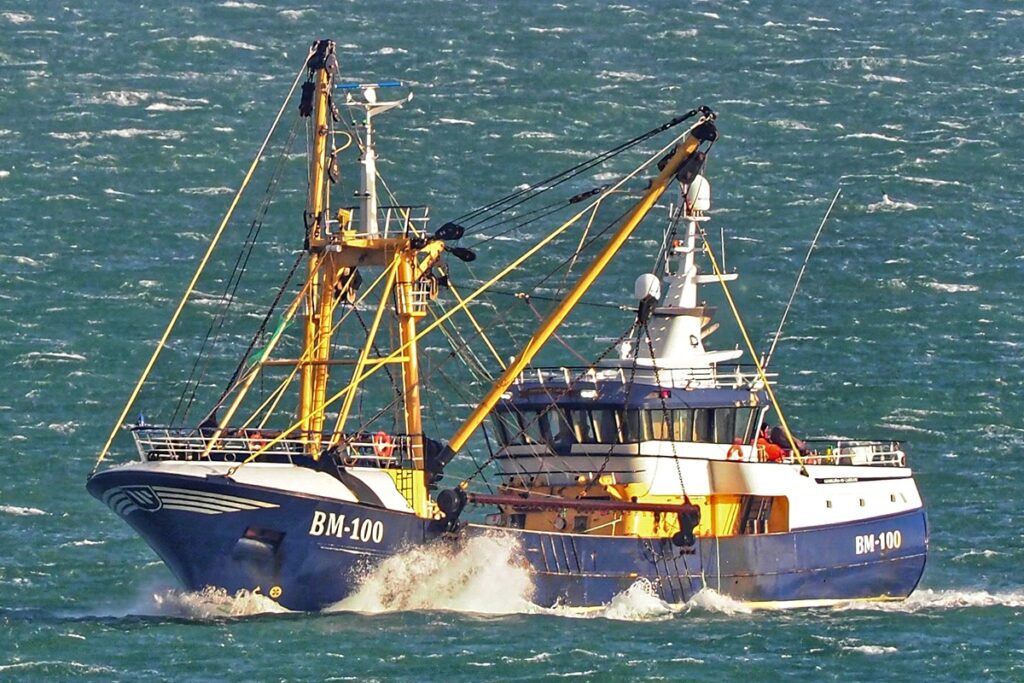
Of 35.25m LOA and 8.70m of beam, the Brixham-based Georgina of Ladram has the distinction of being the biggest new beamer to be built for local owners, and the first for 30 years. Completed by Luyt BV in the Netherlands after the hull and superstructure were built at Ibis shipyard, Burgum, Georgina of Ladram features an electrically driven and pneumatically controlled 10-drum winch. Engineroom machinery includes an ABC 6DZS propulsion unit of 736kW @ 810rpm, a ZF 7.524:1 reduction gearbox, a 3,200mm-diameter fixed-pitch propeller and two Mitsubishi S6B3-MPTAW auxiliary engines running 405kVA generators.
Amethyst BF 19
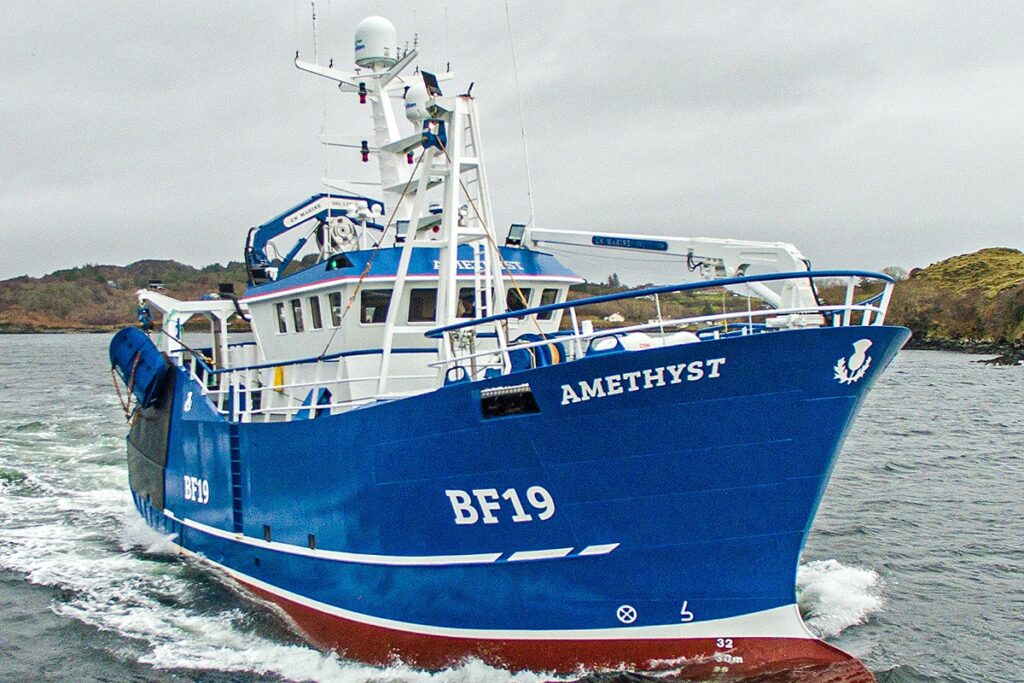
Built to a new round bilge hull design of LOA 20.25m, the Fraserburgh twin-rig prawn trawler Amethyst is the first fishing vessel that Co Donegal boatbuilder Mooney Boats has delivered to owners in Scotland. The vessel was built from the keel to the top of the mast and fully fitted out in the yard’s extensive fabrication hall at Killybegs. Amethyst features a Mitsubishi S6R2 main engine, Reintjes 7.09:1 reduction gearbox and 2,100mm-diameter propeller. Auxiliary power comes from a Mitsubishi 6D24-TC variable-speed engine and a Mitsubishi 6D16T auxiliary engine running a 120kVA Leroy Somer 415/3/50 generator.
Crystal Sea SS 118
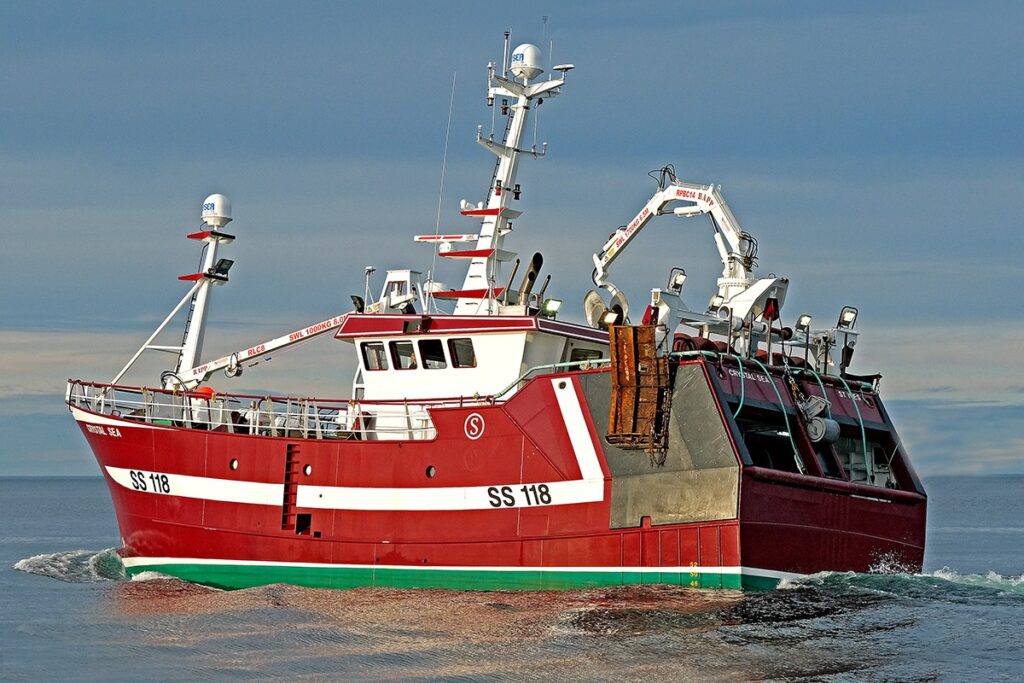
The 24.5m twin-rig trawler Crystal Sea has the distinction of being the biggest vessel built to fish from Newlyn for over 40 years. Typically landing between 25 and 30 different species found on traditional grounds little more than 50 miles off Land’s End, the vessel features an innovative deck machinery package, including two sets of split sweep winches atop the shelterdeck, directly above the usual arrangement of split net drums on the quarter, and three split trawl winches forward. Further innovative features include a customised catch-handling system and an easy-access companionway to the fishroom.
Jacqueline Anne FR 243
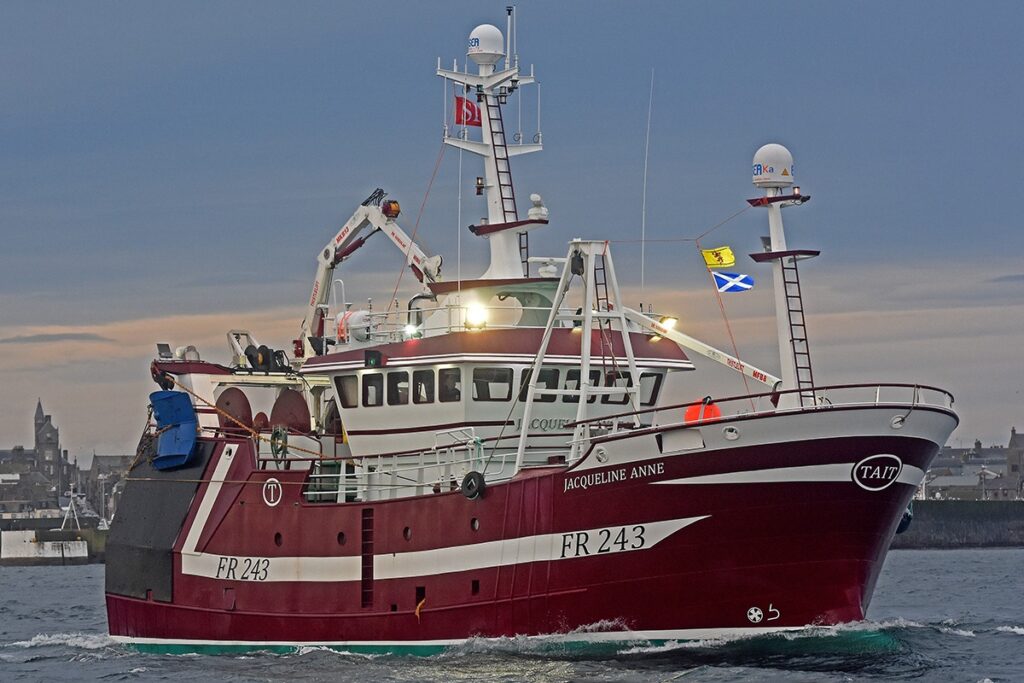
The 24.5m LOA Jacqueline Anne is the first new Scottish twin-rig prawn trawler to feature a variable-pitch propulsion system – chosen to give greater control of the initial bite associated with increasingly large-diameter propellers. Accordingly, the deck machinery, which includes three split trawl winches, two sweepline winches abaft the wheelhouse and two sets of split nets drums on the quarter, is driven by two load-sensing pumps mounted on the main engine gearbox. Additionally, a number of innovative features, most of which are relatively minor when viewed singly, are dovetailed into the overall design for maximum benefit.
Ocean Challenge LK 253
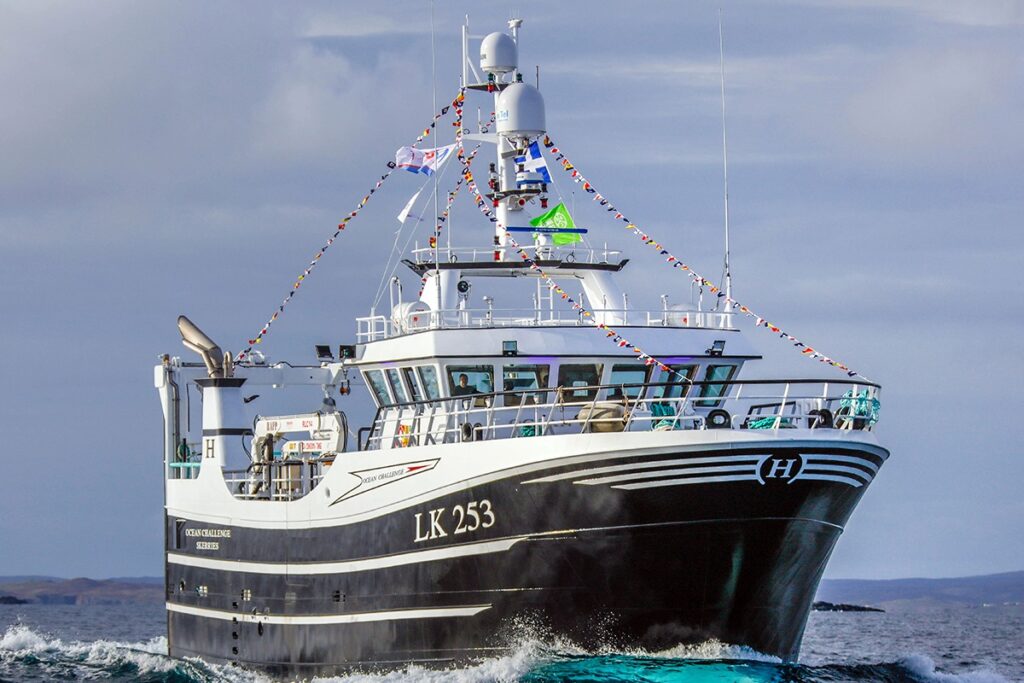
The 28.5m Shetland whitefish trawler Ocean Challenge works twin-rig hopper trawls from two sets of split net drums positioned forward on the full-length trawl deck. Three split trawl winches are mounted on raised saddles on the side decks amidships, forward of elevated bagging drums. Catches are taken aboard centrally at the transom. The vessel’s centreline machinery, which gives Ocean Challenge an average top speed of 10 knots, includes an ABC 6DZ 738kW main engine, a Heimdal HG660S 6.04:1 reduction gearbox and a Heimdal 3,000mm-diameter four-bladed VP propeller. Two 250kVA fully load-sharing electrical generators are driven by Caterpillar 9.3 DITA auxiliary engines.
Reliance III BF 800

With main dimensions of 20.4m LOA, registered length 16.49m, beam 7.7m and draught 5.2m, the new Banff dual-purpose prawn and whitefish twin-rig trawler Reliance III features a new hull design and several innovative ideas that skipper John Clark proposed to enhance crew safety. These include a new design of three-drum winch incorporating hydraulically operated brake cylinders that can be operated from the trawl console in the wheelhouse, and customised safety guards fitted above each barrel of the three-drum winch. A dedicated second rail running around the shelterdeck allows crewmen to clip in their safety harnesses when working on the upper deck.
Pelagic boat of the Year
Lunar Bow PD 265
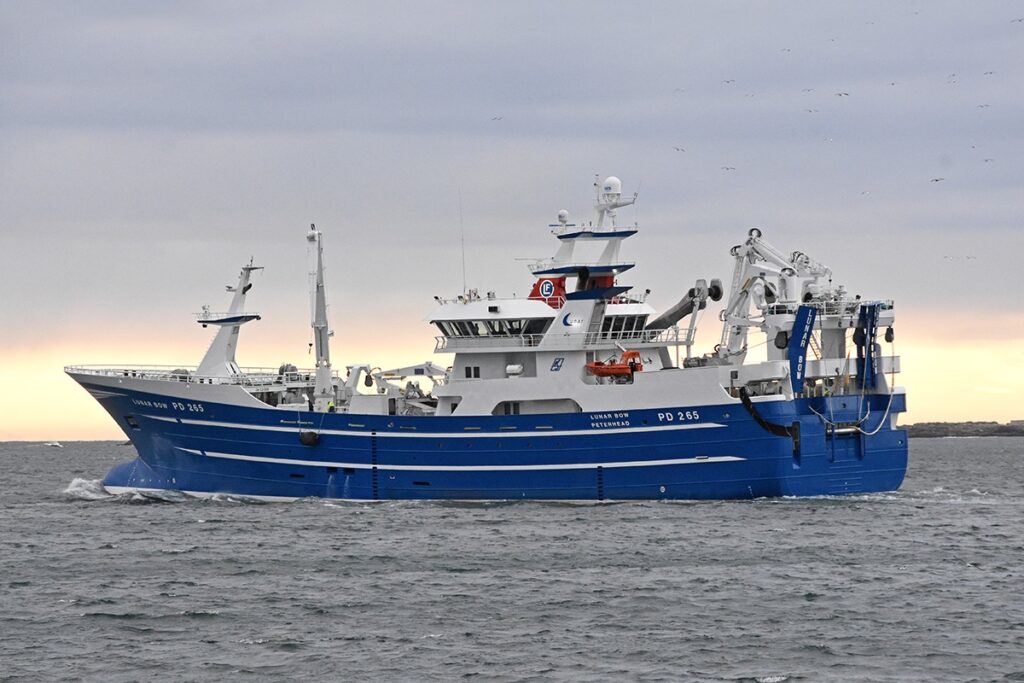
The Peterhead-based diesel/electric-drive dual-purpose purse-seiner/midwater trawler Lunar Bow features a totally new hull design in which the full-length boat deck is capped by a long forecastle/deck/whaleback to give increased freeboard and buoyancy forward when steaming into poor weather. Trawled fish are pumped aboard at the port quarter, while purse-net-caught mackerel are taken aboard on the starboard side amidships. A Tier III-compliant 10V31 engine is part of Lunar Bow’s fully integrated Wärtsilä propulsion system, which includes a two-speed gearbox and a 4,200mm-diameter CP propeller system that can deliver a top speed of 17.5 knots.
Resolute BF 50
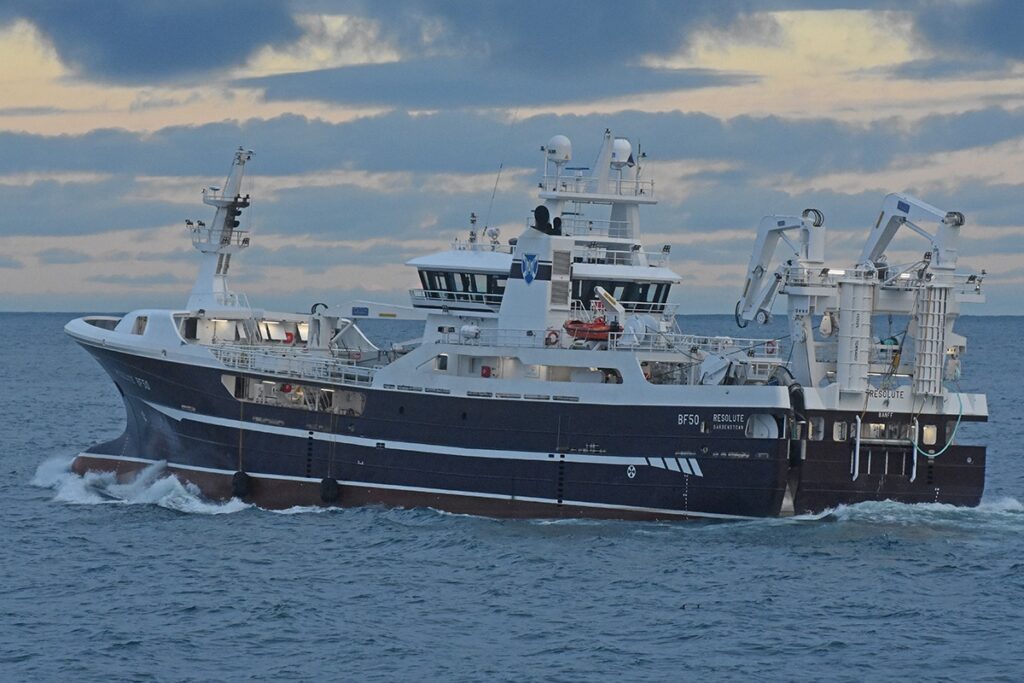
Of 69.90m LOA and a beam of 14.60m, Resolute effectively features three continuous decks – main, shelter and forecastle, with continuous wide side decks extending the full length of the vessel. Designed for pumping pelagic fish over the stern, Resolute’s midwater trawling units are located on three levels – shelter, boat and upper boat decks – in a customised arrangement in line with the owners’ requirements. These include the split trawl close to the hull sides directly abaft the accommodation casing on the forecastle deck, central waterfall-style net drums at shelter/forecastle level, and a lifeline winch on the starboard side of the shelterdeck.
Shellfish boat of the Year
Alcedo BA 77
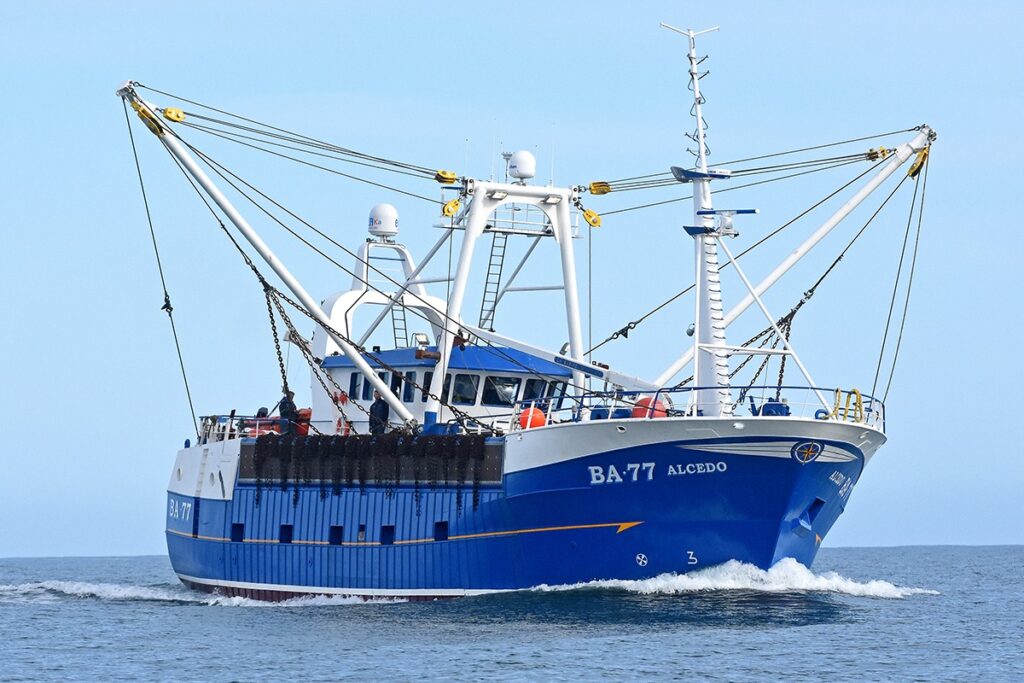
Of 34m LOA and 8.9m of beam, the Kirkcudbright-based dual-purpose queen/king beam scalloper Alcedo features bespoke gear- and catch-handling systems, electric-drive main winches operated through an advanced regenerative power management system, and a customised internal layout in which the accommodation cabins are situated at main deck level. Buoyancy tanks in the form of sealed voids are built into the sides of the hull. Scalloping activity is based around beams mounted at the base of the truncated A-frame main gantry amidships, outer hull tipping doors pivoted on top of the bulwarks that extend up to the level of the shelterdeck, and side receiving hoppers/conveyors.
Isabelle PW 64
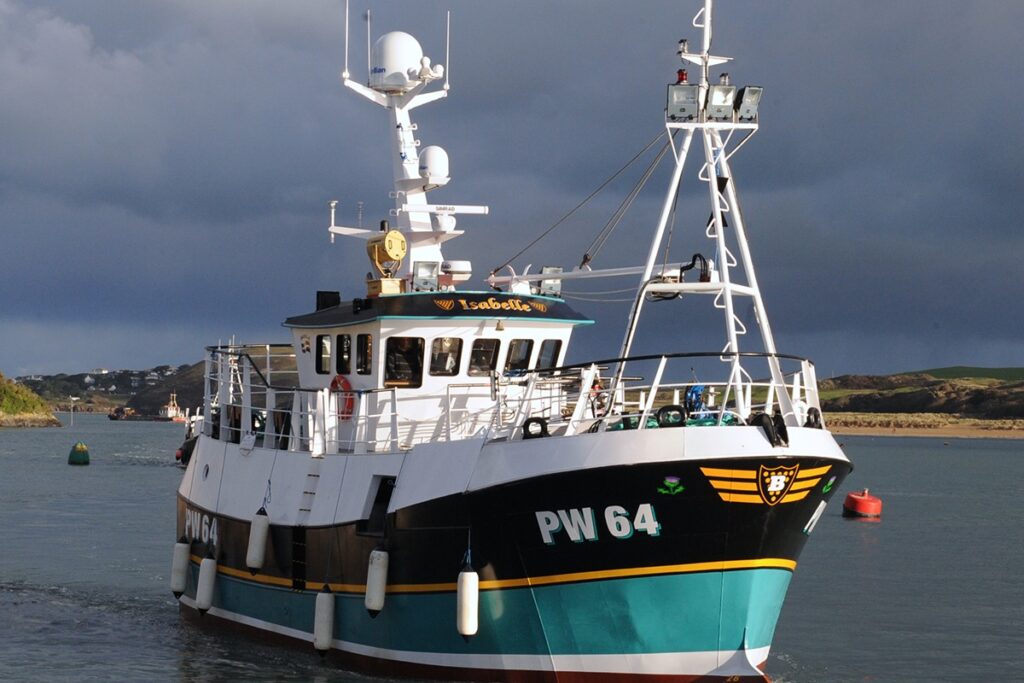
The 14.95m Padstow vivier-crabber Isabelle is based on a well-proven hull design from SC McAllister & Co Ltd and built at Polruan, Cornwall. Of 29,000 litres internal capacity, the crabber’s vivier hold can accommodate 14.5t of brown crab, the seawater being exchanged every 12 minutes by electrically driven Desmi pumps. Engineroom equipment includes a Volvo Penta D3 main engine driving a 1,600mm-diameter propeller through a Twin Disc gearbox of 4.86:1 reduction. Isabelle is arranged for side-shooting, with cleared and rebaited pots being replaced on a table amidships adjacent to the gunwale rail for retoggling to the backrope before going back into the water.
Sharon Anne BH 124 and Shazleah SO 672
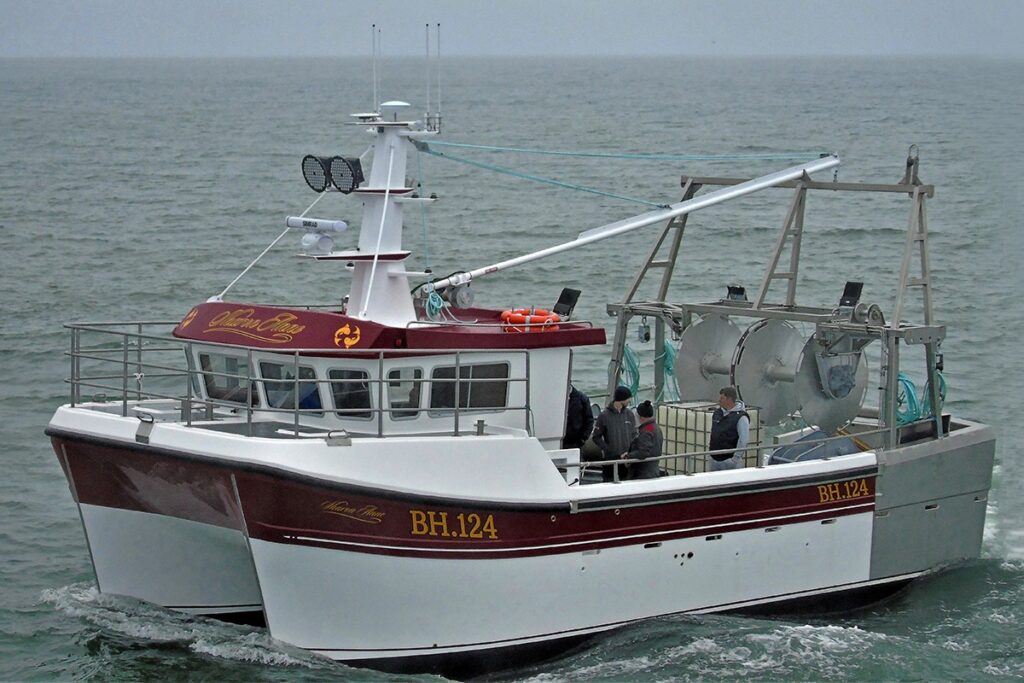

Fishing from Killybegs, Co Donegal, and Blyth, Northumberland, the versatile and very similar potters/trawlers Shazleah SO 672 and Sharon Anne BH 124 are based on a new design of catamaran hull developed over a three-year period by G Smyth Boats of Kilkeel, Co Down in liaison with Ian Macleod. With a beam of 5.5m, the extensive working deck area of both catamarans is well suited to the requirements of potting. This is handled by gunwale rail rollers, Hydroslave 1.5t slave haulers and self-shooting doors in the transom. The vessels feature 3t split trawl winches positioned towards the stern, forward of two elevated 2t net drums mounted within the trawl gantries.
Osprey WK 4
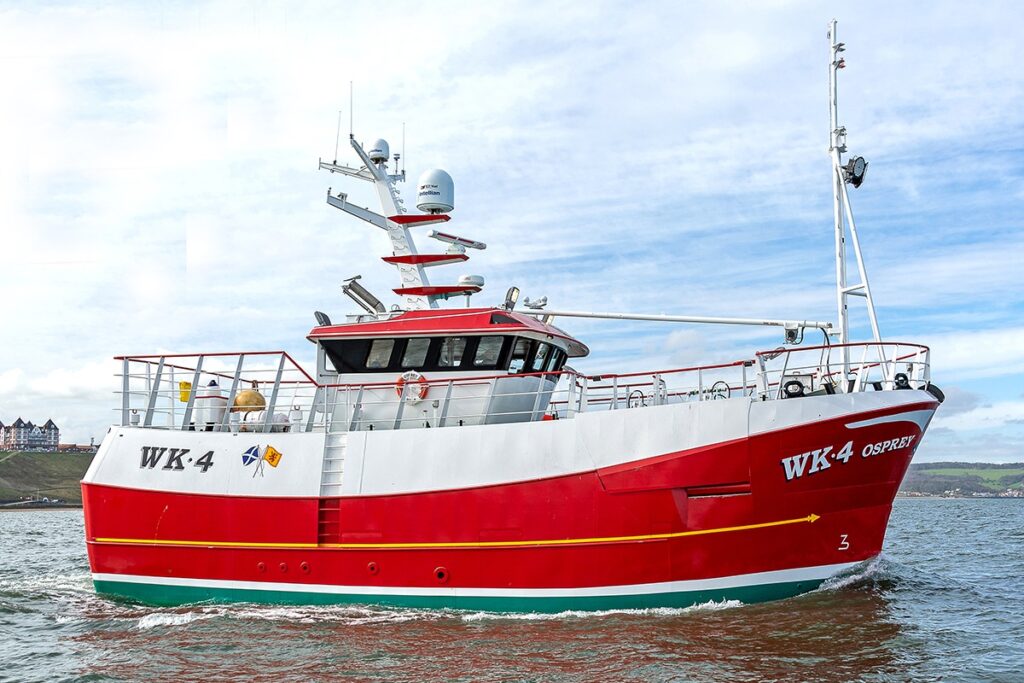
The Scrabster-based 18.8m fully shelterdecked vivier-crabber Osprey incorporates a full-width deck casing arranged across the transom stern under the full-length shelter, leaving two-thirds of the vivier vessel’s main deck clear of any obstructions. The pot hauling station is served by a gunwale rail self-hauling roller and a 2t slave hauler mounted on a hanging box on the underside of the shelterdeck. Backropes are flaked down into a large storage well recessed below the level of the main deck, forward of six toggle bars and a shooting table. The central 32t-capacity vivier hold is served by one of two 6in Azcue pumps driven by 7.5kW electric motors.
Processor of the Year
Flatfish
Starting as a small operation from the iconic docks in Grimsby, Flatfish has faced many changes since it was first founded in 1979.
“Sustainable seafood is our passion, and providing the nation with the highest quality, responsibly sourced seafood is our number one priority,” it says. “We have built transparent and reliable supply chains to provide our customers with an undeniable supply of the best seafood on offer, 365 days a year. With our suppliers’ help, our products have been the centrepiece of millions of UK resident’s dinner tables, and we want this to continue for many years to come. We champion British seafood, constantly pushing to supply more of the best British species to retailers.”
Flatfish tells us that sustainability has been at the forefront of its minds since it began, and it is continuously striving to achieve perfection, making each year more sustainable than the last.
“We are proactive in our approach to social responsibility placing the environment, our employees, and our community at the heart of our business decisions,” it continues. “We want to share our passion and knowledge about fish with our stakeholders while encouraging our industry to put people and the planet first.”
Noble Brothers
Noble Brothers is one of the oldest established fish-processing companies in Fraserburgh. Under the direct control of father and son Ian and Malcolm Smith, who between them have some 80 years’ experience of buying and supplying in the fish trade, it supplies traditional products, prepared using modern techniques and equipment.
Products are shipped daily throughout the British Isles, and beyond. “Earning a very high reputation abroad for being of consistent good quality and sizing, our name appears in markets throughout Europe,” the company says.
Noble Brothers also operates a small retail outlet of its own, Sotties Fish Shop. With a large selection of fresh and smoked products available daily, the company is also looking to branch into online sales in the near future.
Sole of Discretion
Sole of Discretion started trading in May 2016, and sells to organic online delivery companies as well as independent farm shops and delis across the UK. It is a Community Interest Company owned by the fishers who land to it.
The company was born of a desire to make it easier for the conscientious shopper to eat fish without that nagging doubt that they might be contributing to a depleted and damaged marine ecosystem. Sole of Discretion is unique in the UK in that it offers full traceability on each and every pack back to the boat. It is the only fishmonger with a Soil Association-approved manifesto.
“We are 100% committed to ethical, quality fish, and hence buy mostly from static gill- or trammel-netters and handliners fishing mostly out of Plymouth. We never buy from industrial trawlers or from boats over 10m. We also encourage people to move away from farmed fish,” the company says.
Independent Retailer of the Year
By The Harbour, Stornoway
After originally selling fish from the back of a van, Sean Clark progressed to buying a small retail premises. This proved so popular he needed to expand again, resulting in the opening of the By The Harbour fishmonger and seafood takeaway. Sean now employs two chefs, who use seasonal fish landed by the local fleet to make oven-ready dishes such as fresh fishcakes and monkfish curry for people to take home and enjoy. The shop also has a tempting counter of fresh-caught local fish and seafood.
The new shop is doing its best to keep the local economy thriving; in addition to buying the local catch, it sources other ingredients from local shops.
Sean said: “We didn’t realise just how popular our fresh fish and prepared meals would be. This year has been a challenge for all, and we would like to thank all our customers past and present for the constant support throughout.”
Donaldson’s, King’s Lynn
Donaldson’s has been a name associated with fresh fish in King’s Lynn for well over 100 years. Steven John and his wife Deanna bought the business 35 years ago when the Donaldson family retired after three generations.
Four years ago, on Christmas Eve, a devastating fire gutted the premises. But after a refit, Donaldson’s was up and running again. The team say that the global pandemic introduced a new audience to its produce, and they are delighted to be serving more and more customers who want a safe, personal, friendly service combined with fresh local produce. Over the past year, the range has expanded to include a counter of made-on-site products including fish pies, quiches, fishcakes and curries.
Donaldson’s tell us they’ve finally embraced the 21st century by launching a Facebook page. They receive great feedback, and messages from customers, who send in pictures of the dishes they cook. “It has become like a little fish community,” they say, “with the staff sharing daily specials and sharing ideas with each other.”
Lyme Bay Fish Shack, Dorset
Lyme Bay Fish Shack is run by husband and wife team Nigel and Corinne Birt, who started the business in 2012. Over the years they have expanded to a new shop and prep room, which was built in 2019.
The team has its own boat, KT-SAM E 10, run by Nigel and their son Sam, which works out of Lyme Regis. They pot for lobsters and crab, use static nets for Dover sole, plaice, etc, and rod and line for bass, pollack and cod.
“We are extremely proud of our shop, fish and staff, and in the past 12 months have assisted one of our fishmongers to achieve his Master Fishmonger recognition,” they say. “We purchase our fish direct from Brixham market, and other local fishermen also supply to us.”
World of Fish, Lowestoft
World of Fish is run by Alan Snow and his son Bryan, who have over 30 years’ experience in the trade and pride themselves on their fresh fish display – probably the largest, most varied display in East Anglia.
Customers are enthusiastic. One nominator said: “The most beautiful selection of fresh and frozen fish. A visit to the shop is such a wonderful experience. Customers are always made so welcome. The staff couldn’t be more helpful, and their advice and suggestions are always great.”
Another told us: “This is a fantastic shop which sells a fabulous selection of fish and shellfish, fresh, frozen and smoked. The boys are brilliant – extremely helpful and friendly. I travel nearly 10 miles to shop there, but many travel much further. That has to say something about them!”
Dorset Shellfish, Portland
The Dorset Shellfish team are a fishing family with two boats, Marauder and Raider, that mainly fish for crab, lobster and line-caught bass. They also buy fish from other Weymouth and Portland boats. Shoreside, they cook the lobster and crab, hand-pick it, and sell direct to the public from farmers’ markets, pop-up stalls or direct from their tiny shop in Portland.
“We have been fishing, processing and selling all the way through the pandemic, encountering all different challenges!” they tell us. “We are enthusiastic about promoting local seafood. We are always keen to advise on cooking fish and shellfish to make it as easy as possible for customers.”
One nominator said: “An amazing family team who sell local seafood, truly representing the quality products that are caught by Dorset fishermen. Caz and her team go above and beyond in supporting local fishermen, and provided employment when skippers and crew were feeling the effects of Covid market crashes.”
Service Company of the Year
John Reid & Son
John and Margaret Reid formed John A Reid on Islay in 1972. By the late 1970s, the company had established itself in the manufacture and repair of fishing gear on the west coast of Scotland. Over the years it has expanded its services throughout the UK.
Forty years later, the business, now known as Reid Scallop Gear and Chandlery, is still a family concern. John and Margaret were joined by their son Jonathan, who opened a new workshop in Brixham in 2007, which has full facilities for repair, renovation and manufacture of scallop gear, as well as space for its chandlery store. This move was so successful that in 2010 the company relocated its entire business to Devon.
One nominator said: “This company shows great adaptability and innovation with gear for the scallop industry. They offer great customer service and go out of their way to provide what you want fast and efficiently.”
Thistle Marine
Thistle Marine, with specialist support from its two group divisions, undertakes the design, manufacture, service and repair of cranes and deck equipment for the fishing industry. The company prides itself on its ability to conceptualise and then engineer an appropriate solution for any boat within budget and on schedule.
One nominator said: “Thistle Marine has been in the fishing industry for many years, providing service and repair to various fishing vessels around the UK and Ireland. They’re a family company that deliver a service that’s second to none.”
Another said: “This company has stayed loyal to the fishing industry for over 40 years, offering repair and service of vessels’ hydraulic systems, and also new-vessel hydraulic packages. It is a 24-hour-service company that has clients all round the UK.”
Parkol Marine
Established in 1971, Parkol Marine Engineering Ltd is a shipbuilding and vessel repair company based in Whitby. A second yard was opened in Middlesbrough in 2017 to service demand for bigger, more diverse vessels.
The Whitby facilities comprise two worksheds and two boatbuilding berths for vessels up to 27m long and 8m beam. The floating dry-dock has a capacity of up to 450t, and a mobile crane with 50t capacity. The Middlesbrough yard comprises a 70m by 35m shed that accommodates larger builds between 25m and 45m.
From new builds to repairs, conversions and refurbishments, Parkol’s reputation is built on providing bespoke products and quality service utilising its 87 skilled staff. The company has built 49 vessels from 10m to 34m for all types of fishing methods. It has a UK-wide client base, and a build in progress for Ireland.
The Sustainability Award sponsored by The Fishmongers Company
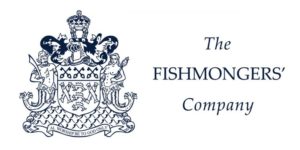
Manx Fish Producers’ Organisation – Ramsey Bay king scallop fishery
After Ramsey Bay was closed to mobile fishing and the area was designated a Marine Nature Reserve in 2011, a detailed seabed survey was carried out which subdivided the bay into separate zones. This included a future fisheries zone as well as fully protected areas.
From 2012, the fisheries zone was surveyed annually to see how the scallop stocks recovered, and in 2013 it was decided to allow a small fishery to take place. From 2015, the Manx fishing industry, through the Manx Fish Producers’ Organisation (MFPO), took over the annual surveys. On the basis of each year’s findings, a TAC is agreed between industry and fisheries scientists.
The harvest strategy is then developed for that season’s fishery, designed to ensure minimum impact on the seabed and a reduced carbon footprint, all monitored in real time using a smartphone app.
Densities of king scallops within the fisheries zone of the reserve have now reached a constant level. The catch rates are typically five to 10 times higher than those in the wider Manx Territorial Sea, and the average size of king scallops landed is also greater, meaning fewer need to be caught, making the fishery very sustainable.
SafetyNet Technologies
SafetyNet Technologies (SNTech) aims to enable sustainable practices in the industry through the application of technological advances. Its first commercialised product, Pisces, uses light to help attract or repel different species of fish and marine life. By giving fishers greater control of their catch composition, Pisces can improve their fishing revenues and reduce bycatch by up to 90%.
“Through the commercial launch of Pisces, SNTech is one step closer to its goal of enabling precision fishing for a world where the ocean and humans can thrive together,” says the company.
SNTech is also developing other solutions to support precision fishing and work towards its goal of ‘saving more fish, helping fishermen, and protecting an increasingly essential food source now and for the future’.
Scottish Inshore Fisheries Integrated Data System – University of St Andrews
The Scottish Inshore Fisheries Integrated Data System (SIFIDS) project, conceived and led by members of the Marine Alliance for Science and Technology for Scotland (MASTS) directorate, is based at the University of St Andrews, and is an integrated system for collecting and analysing data from the Scottish inshore fleet.
“As pressures on Scotland’s inshore waters grow, not just from fishing but also demands from the offshore renewables, aquaculture, leisure and tourism sectors, accurate information on these activities is needed by the Scottish government to inform effective marine planning,” the project team say.
An example of the project’s data-gathering systems being used to advance sustainability is the Outer Hebrides Regional Inshore Fisheries Group’s Pot Limitation Pilot, which aims to help reverse decreasing catch-per-unit effort rates and reduce gear conflict between static- and mobile-gear vessels. SIFIDS’ low-cost tracking device has been used for the scheme, monitoring the location of static-gear fishing activity and determining when gear is shot and hauled, improving the evidence base on which fisheries management decisions in the area are taken.
BATmap – University of Aberdeen (Tara Marshall), Scottish Fishermen’s Organisation (Paul Macdonald) and Chordata Ltd (Eric Torgerson)
Following the implementation of the landing obligation, the demersal fishery in Area VIa was incentivised to reduce by-catch of cod, which was at risk of becoming a choke species.
Consultations with Scottish skippers operating in VIa indicated support for trialing real-time reporting (RTR) for by-catch avoidance, but also highlighted their reluctance to share information beyond their already established networks. To promote acceptance of RTR, the research team committed to co-designing the software package with the skippers who would be using it.
BATmap (Bycatch Avoidance Tool using mapping), the bespoke software that resulted from this process, was launched in June 2020. It combines catch reports with vessel position data, allowing skippers to generate maps of their vessel’s data on demand. When an alert threshold catch value is exceeded, details of the location and volume of the catch are shared with participating skippers. This conveys the location of potential hotspots while preserving the anonymity of reporting vessels.
Going forward, BATmap’s features and operational settings will evolve as skippers become more accustomed to sharing information.
Port of the Year
Fraserburgh
2020 was a busy but challenging year for Fraserburgh, say the harbour commissioners, due to the impact of Covid-19 and Brexit. “As the port’s business was essential in maintaining fresh food supply, the commissioners and businesses quickly adapted in line with government guidance to ensure operations continued as smoothly as possible, whilst keeping employees and port users safe,” they say.
The commissioners say they are committed to increasing fish landings through the port, and have therefore continued to invest over the past year in maintenance, repairs and upgrades to the harbour’s infrastructure. The Fraserburgh Harbour Masterplan, which was completed in 2019, has been updated to include the ability to deliver alternative green energy to fuel vessels. This builds on the ship-to-shore power project, which has seen the green credentials of the port boosted by vessels utilising the service and switching off their engines whilst in port.
Newlyn
“We aspire for Newlyn to become the UK’s leading port,” say the Newlyn harbour commissioners. “That is why we are transforming Newlyn harbour to provide fit-for-purpose facilities, services and expertise that support the development and sustainability of the fishing industry.”
The harbour commissioners and advisory board have now shared plans for the improvement of the harbour infrastructure. “We are seeing an increase in larger fishing vessels in Newlyn, and as a port we need to do everything we can to facilitate them,” said harbour master Rob Parsons.
The development of Sandy Cove will enable Newlyn to welcome boats with deeper draughts, and a proposed breakwater will act as protection from storms.
Eastbourne
Some 30 years after the idea was first mooted, and seven years after local fishermen began working with the New Economics Foundation to put together a funding proposal, work began last summer on the new fishermen’s quay at Sovereign Harbour in Eastbourne.
The first phase of construction will encompass the new quay, a cold storage and processing unit, a smokery and a fishmonger’s. Further phases will see the construction of storage and repair space and a visitor centre.
One nominator said: “Sovereign Harbour has transformed into a fishing harbour this year, with over £2m of investment into the fishing quay, transforming the harbour and prospects for the fleet, now and long into the future. An inspiring transformation, led by the fishing community.”
Lerwick
The first whitefish to be landed into the new fishmarket at Lerwick in August 2020 marked a major milestone for all concerned. Featuring four temperature-controlled bays covering a floor area of 1,600m2, double the capacity of its predecessor, the new market building, which includes first-floor office accommodation for all the relevant fishing associations in Shetland, marked the culmination of a farsighted £30m-plus project to create a modern hub for the fishing industry that started over 10 years ago.
Work included initial pre-dredging, constructing the 150m-long Mair’s Quay, reclaiming 1.45 hectares of land on which the new market and its service area now stand, and construction of the L-shaped Holmsgarth North development, which created 800m of deepwater berthing.
Lifetime Achievement Award – Sponsored by SWFPA
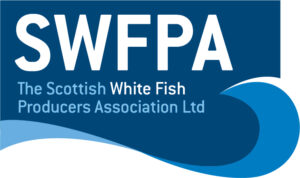
Selected by an industry panel, the recipient of this year’s Lifetime Achievement Award will be revealed in our winners’ video on 17 June.
Now that you’ve read all of this year’s shortlists, it’s time to pick your favourites and click here to cast your votes for your chosen candidates. Join us at: fishingnews.co.uk at 7pm on 17 June to find out the winners of the Fishing News Awards 2021.
With thanks to all our sponsors and our Safety Partner, FISG.
